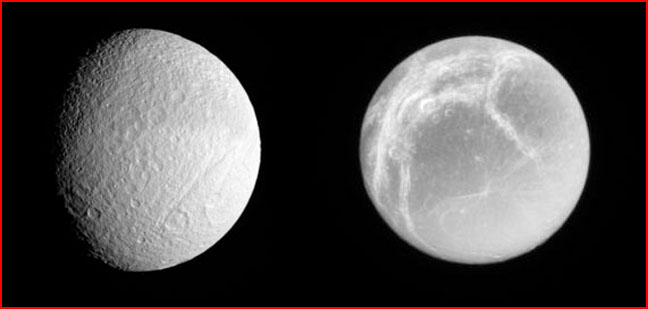
home •
about •
essential guide •
picture of the day •
thunderblogs •
news •
multimedia •
predictions •
products •
get involved •
contact
picture of the day archive subject index
Saturn’s moons Tethys and Dione Credit: NASA/JPLNov 27, 2007
Saturn's Electric MoonsWe have long contended that "geysers" on Saturn’s moon Enceladus are part of the electrical circuitry of Saturn. Now NASA has announced new evidence that Saturn’s moons Tethys and Dione are part of this same circuitry.
In previous Thunderbolts Pictures of the Day, we presented several examples of how Jupiter’s highly charged, electric environment creates features on the planet’s small moon Io that cannot be adequately explained by conventional scientists. The observed phenomena are deemed “mysterious,” and they appear to contradict the theory of an electrically neutral solar system. Similarly, Jupiter’s moons Ganymede and Europa electrically influence the gas giant’s plasmasphere.
The Cassini-Huygens mission was launched from Cape Canaveral on October 15, 1997. Its primary mission was the exploration of the Saturnian system, including its atmosphere, its rings, its magnetosphere and a number of its moons. Although Titan was the highest priority, the mission has brought many surprising discoveries, and among the greatest of these have been the icy plumes erupting from the south polar region of Saturn’s moon Enceladus.
The image above shows two more of Saturn’s moons, Tethys (left) and Dione (right). Both are now known to be actively interacting with the electric field of their parent body.
In a June 13, 2007 European Space Agency release it was announced that the two moons are “flinging great streams of particles into space.” The discovery was made by the Cassini Plasma Spectrometer, when data from Saturn revealed that the ionized gas (actually a plasma) surrounding the planet was trapped within its magnetic field and (to use NASA’s archaic expression) being “squashed into a disc.”
The language used by NASA scientists continues to amuse plasma experts. The ESA release notes that Saturn rotates at a very high speed for its size and mass, and from this the investigators deduced that the ionized material is forced out mechanically. “Just like a child on a fast-spinning merry-go round, the trapped gas feels a force trying to throw it outwards, away from the centre of rotation.” According to the report, the instruments found that when the material is removed more tenuous and hotter plasma enters the empty regions within the field. That additional plasma has been traced to the active moons. (“Tethys and Dione as sources of outward-flowing plasma in Saturn’s magnetosphere”: J. Burch, J. Goldstein, W. Lewis, D. Young, A. Coates, M Dougherty and N. André. Nature, June 14, 2007).
As in other instances of electrical discoveries in planetary environments, NASA scientists can only see internal pressure, centrifugal force, and “gas flow.” Of course, they are aware that plasma makes up more than 99% of the visible universe, but they have yet to consider the role of charge distribution within the plasma of space. Instead, a charge-neutral solar system is held up as the sine qua non of theoretical speculation.
In contrast, electrical theorists argue that Saturn moves within the plasmasphere of the Sun and interacts with the Sun’s electric field. Planets and moons in the solar system are charged bodies. They are not isolated in “empty” space, but “converse” electrically with each other. Because Enceladus, Dione and Tethys all move within the plasmasphere of Saturn, it is only to be expected that they would transact electrically with their primary.
The researchers who make up the Thunderbolts team have been asserting for many years that plumes, geysers, and jets rising from the moons of gas giants are plasma discharges. NASA’s investigators seem unable to comprehend the observational evidence, preferring to describe the activity on these moons as forms of “volcanism.” That is why they were caught by surprise when the Galileo mission revealed that the plume of Prometheus on Io had moved more than 80 kilometers (50 miles)!
The simplest, most straightforward explanation of the charged particles spewing from the icy moons of Tethys and Dione is electric discharge, so there is no need to conjure implausible internal dynamics to account for these remarkable events. We predict, therefore, that investigation over time will show that the active sources of charged particle streams from Enceladus, Tethys, and Dione all move across the surface.
By Stephen Smith
___________________________________________________________________________Please visit our Forum
The Electric Sky and The Electric Universe available now!

|
|

|
EXECUTIVE EDITORS:
David Talbott, Wallace Thornhill
MANAGING EDITORS:
Steve Smith, Mel Acheson
CONTRIBUTING EDITORS: Michael Armstrong, Dwardu Cardona,
Ev Cochrane,
C.J. Ransom, Don Scott, Rens van der Sluijs, Ian Tresman
WEBMASTER: Brian Talbott
Copyright 2007: thunderbolts.info
![]()
home •
thunderblogs •
forum •
picture of the day •
resources •
team •
updates •
contact us

